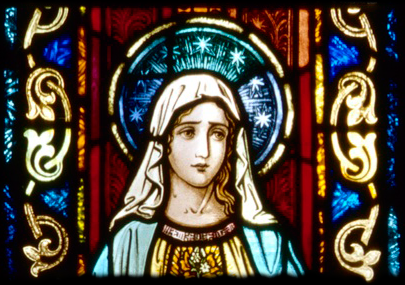of
BLESSED VIRGIN MARY
Chapel
then do what's possible; and
suddenly you are doing the impossible.
- St. Francis of Assisi

The Design
The Foundation & Cornerstone
The Stained Glass Windows
The Bell & Bell Tower
The Name
The Altar, Cross, & Statuary
The Organ
The Details
The Dedication
The Flagstaff Economy – 1930
Rev. Edward D. Albouy
Donors Of Statues & Other Gifts –1930
The Design
In 1928, consultation began between Fr. Albouy, church trustees, and parishioners regarding size, interior arrangement, and costs for a new church. Donation of three lots by David Babbitt determined the building site on the northeast corner of Beaver and Cherry Streets.
In April 1929, architect Emmet G. Martin of Los Angeles, a specialist in church design, submitted water color sketches and construction drawings for the Chapel-Gothic style church. The projected cost of the new building and furnishings was $65,000.

The stately church was to be constructed of native stone. The gathering of hundreds of lichen-covered malpais rock – collected by parishioners “several at a time or by the wagon load” – avoided an expense estimated between $10,000 and $15,000.

In his “History of the Catholic Church in Flagstaff,” M. J. Riordan describes the architect’s purpose, “To produce a rugged, fortress-like structure with deep shadows that would fit in and be a part of the bold mountain background, while embellishing it at the same time with the lightness of contrasting color and the effect of airiness produced by long lines, slender windows, and deep splays, and the remarkable, noble tower.”


(The church boasts 16 gargoyles, decorative cast stone, buttresses, and a 92’ bell tower. These elements have suffered extensive deterioration. Of the gargoyles, all are severely compromised, many are missing. Molds of the gargoyles have been made for future restoration.)

The Foundation & Cornerstone
On September 20, 1929, The Coconino Sun reported foundations for the church were begun. Construction, halted during the heavy winter weather, resumed the following spring in April of 1930.
 Laying of the cornerstone at the new Catholic Church of the Nativity, on the northeast corner of Beaver and Cherry, on May 18, 1930. MARY SWITEZER COLLECTION (Photo by Carson)
Left to right- Edward Jakle, Jack Verkamp, Edward “Bud” McNamara, Reverend J.E. Tremblay (Williams pastor); Right Reverend Daniel J. Gercke (Bishop of Tucson); Reverend Edward Albouy (Flagstaff pastor), Bob Moran, Bill Costigan, and Larry Dunklin.
Note trowel in Fr. Albouy’s hand.
Laying of the cornerstone at the new Catholic Church of the Nativity, on the northeast corner of Beaver and Cherry, on May 18, 1930. MARY SWITEZER COLLECTION (Photo by Carson)
Left to right- Edward Jakle, Jack Verkamp, Edward “Bud” McNamara, Reverend J.E. Tremblay (Williams pastor); Right Reverend Daniel J. Gercke (Bishop of Tucson); Reverend Edward Albouy (Flagstaff pastor), Bob Moran, Bill Costigan, and Larry Dunklin.
Note trowel in Fr. Albouy’s hand.M. J. Riordan wrote, “The work was not let by contract, but by the day, and it proceeded so well that the walls were half finished by Sunday, May 18, 1930, when the Bishop, Rt. Rev. Daniel J. Gercke, assisted by the pastor and Rev. J. E. Trombley of Williams … with solemn rites laid the cornerstone.”
The Coconino Sun further reported a copper box was sealed in the masonry “with a special trowel, accompanied by song and prayer.” A mini time-capsule, the box contained the usual documents encased in the cornerstone: the name of the current president, Herbert Hoover; the name of the governor of Arizona, John C. Phillips; the mayor of Flagstaff, Daniel L. Hogan; the names of church dignitaries; newspapers and several current coins. The engraved cornerstone reads “Church of the Nativity-A.D.1929.”

The Coconino Sun story continues:
“The trowel used by Bishop Gercke was presented for the occasion by Emmet G. Martin of Los Angeles, the architect of the church building. It is the custom to auction off such accessories for the benefit of the building fund, but in this instance the bishop circumvented the plan by offering $500 for the tool, saying that if anyone wanted to give more, he or she could do so. The bishop got the trowel, which he announced he would treasure among his sacred souvenirs.”
Bishop Gercke also donated the statues of St. Peter and St. Paul for the south facade of the church.
(All exterior statues are showing signs of fracturing from “iron jacking,” the expansive force caused by the rusting of interior steel reinforcing rods.)

The Stained Glass Windows
Commissioned by Fr. Albouy, the Munich-style stained glass windows are an integral part of Gothic architecture. Made of hand-blown German stained glass, the windows were built and installed by master craftsman Jesse Earl Fink of the American Glass Company, Los Angeles.
The exceptional detail in the windows is achieved by painting transparent lead-based paint onto stained glass pieces cut to fit the outlines of the image. The glass is then fired, fusing the paint to the surface, then assembled into a traditional lead came framework.
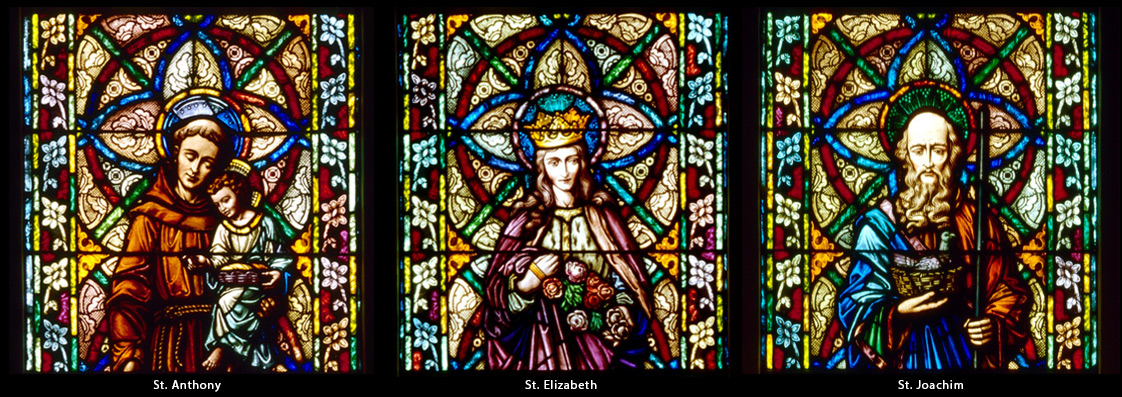
(Many windows have broken pieces of glass, loose reinforcing bars, or sagging or bulging lead frames. Some require immediate repair. Some are in need of complete restoration, while others can be repaired in situ. Though much of the lead is in remarkably good condition, all the windows will eventually need to be re-leaded as the lead came reaches the end of its useful life. Protective shields installed many years ago have yellowed and are otherwise compromised, and also require replacement.)
READ MORE: The History of the Stained Glass Windows
The Bell & Bell Tower
The bell, named “The Star of Bethlehem,” was made in 1889 by the historic McShane Bell Foundry, Baltimore, MD, and was moved from previous church locations. Weighing nearly 1100 pounds, a Latin verse inscribed in golden letters on the bell reads:
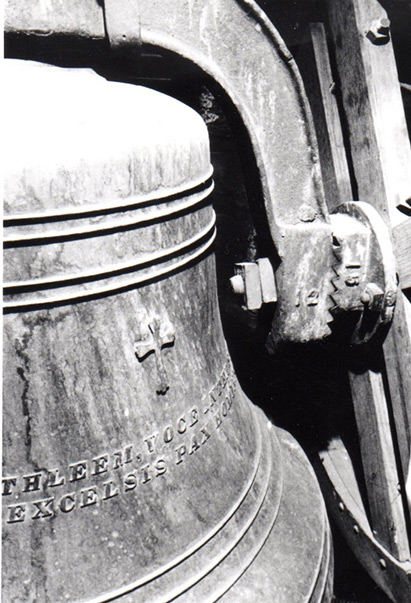
‘I am called the Star of Bethlehem,
And amongst the stars I ring:
Glory to God in High,
Peace and good will to men.’
(The interior of the bell tower shows heavy efflorescence, a sign that water trapped behind the exterior elastomeric paint has penetrated the concrete structure. The rope - visible at the top of the tower - once held the bell, which is now installed in the new San Francisco de Asis Church.)

READ MORE: about the BELL in 1888 – History of the Catholic Church in Flagstaff
The Name
The inaugural services in the original Catholic church on Brannen Street were celebrated at midnight mass on Christmas, 1888. In commemoration of this, the church was given the name Church of the Nativity. This name was retained when the first church was vacated in 1911, and services relocated to the newly built hall of St. Anthony’s School, taking along the high altar, the bell, and various statuary.
In 1930, construction of a new church gave the parish priest, Rev. Edward Albouy, the opportunity to change the name from Church of the Nativity (of Jesus), to Nativity of Blessed Virgin Mary, but it is unclear exactly how the renaming came about. Many were initially unaware of the name change, as reflected in The Coconino Sun article dated Dec. 5, 1930, announcing the dedication ceremonies, which referred to “the new Roman Catholic Church of the Nativity.”
The new name, Nativity of Blessed Virgin Mary, is inscribed on the lower edge of the vestibule window above the main entrance. As seen below, the window depicts St. Anne sitting on a throne holding baby Mary, while St. Joachim, Mary’s father, kneels nearby.

In a letter dated August 26, 1930, to Reverend James P. Davis, Tucson, AZ, M. J. Riordan discusses the name change as follows:
“I think it was in a talk between the Bishop and myself that the question of the new name of the church developed. I know that Father Albouy was under the impression that the old name was The Church of the Nativity of the Blessed Virgin Mary, but my own recollection, which I never expressed to Father Albouy for fear of upsetting him, was that it was named in honor of the nativity of Our Lord. I am quite positive of this as I heard Father Ferrari say when the first Mass was said in the old church on Christmas day, that the church would be named The Church of the Nativity on that account. I don’t imagine that there was ever any document or anything else filed in relation to this at the time. You know in those days there wasn’t very much attention paid to matters of this kind. The priest in charge went along and did just as he thought right and let it go at that.”
The Altar, Cross, & Statuary
The ornately carved high altar graced the two previous Nativity parish churches. In this photograph in St. Anthony’s hall, the statue of The Sacred Heart of Jesus is clearly discernable in the central niche, while the statue of the Mary as the Immaculate Conception stands to the right on a separate pedestal.
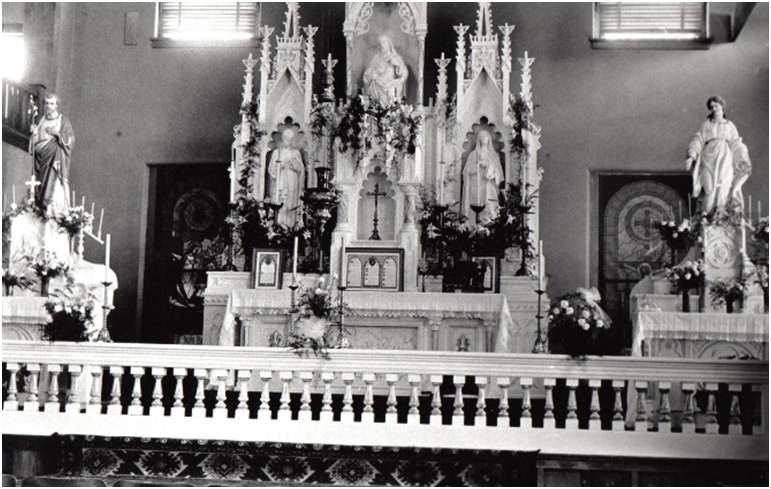
The white altar was painted brown with gold highlights when moved to the newly built Nativity of Blessed Virgin Mary Church, and the central statue was changed. In keeping with the new name, the statue of Mary, embellished with a seven-star lighted halo, was placed in the central niche. The other two statues, St. Aloysius Gonzaga and St. Clare, remained in place.

Details: the golden tabernacle and the carving of the Last Supper on the base of the altar.

Two statues of kneeling angels holding lighted candelabra, as seen in this 1977 Arizona Daily Sun photograph, were originally on either side of the high altar. These were removed when the large mural was installed in1979. The angels have since been refurbished and are in the new San Francisco de Asis church.

Aside from the high altar (circa 1896), other original “furniture” transferred from earlier Nativity churches to Nativity of Blessed Virgin Mary Church were a large cross (circa 1888), the bell (1889), and some statues. The cross hung over the main altar in the first Nativity church as seen in this early photo below. Both the cross and bell have since been moved to the new San Francisco de Asis Church. The shadow of the cross can be seen in this photo taken in the east transept during inspection of the stained glass windows in August 2015.
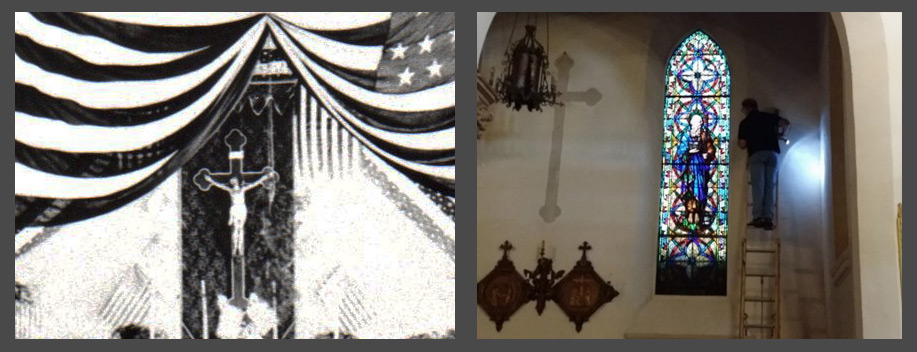
Other interior statues include: West transept: Sacred Heart of Jesus, St. Anthony, and St. Anne with young Mary; East transept: St. Theresa, St. Joseph, and the Pieta; Nave: Infant of Prague, St. Jude, and the Stations of the Cross; Vestibule: Mary & Infant Jesus.
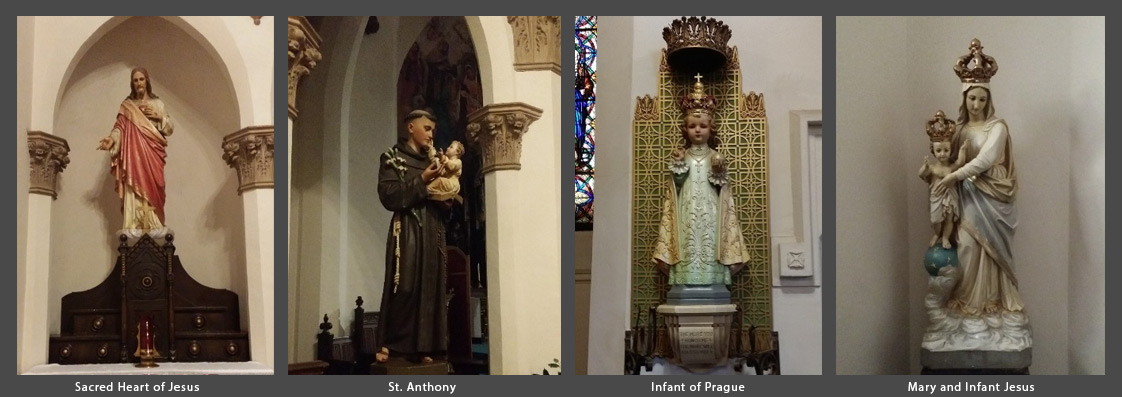

The exterior statuary was integral to the design of the building, and includes statues of The Sacred Heart of Jesus and Mary with baby Jesus (west elevation), St. Peter and St. Paul (south elevation), and four angels on the bell tower. Of the four angels, only three have wings, the fourth - sans wings - can be seen on the right in this photograph.

The Organ
On March 9, 1889, an announcement in the local paper The Champion reported, “A new, magnificent organ is at the depot to be used at the new Catholic Church.” This would have been the Brannen Street church. This organ was relocated to subsequent parish churches, and was played by Edna Buggeln Babbitt during the dedication ceremonies for Nativity of Blessed Virgin Mary Church on December 7, 1930.
Mrs. Babbitt died in 1937 at the age of 43. Her husband, Edwin D. Babbitt, presented the parish with this beautiful new 52-pipe organ in memory of his wife.

The Details
In “The History of the Catholic Church in Flagstaff,” M. J. Riordan writes,
“The central front window is a daring and magnificent piece of work, generous in broadness and height, delicate in every detail, and perfectly balanced between the noble cross above, the fine piece of stonework about the main doorway, which cuts across the straight line of the lintel, and sets off the whole front in simple but striking dignity. The rugged buttresses, especially on the west side, flanked at the roof line by gargoyles symbolic of local fauna, were so devised to throw cool shadows of a mountain spring in the midst of pines and aspens.
The completion of the interior is to be a work of love and time. The details have been worked out so that everything will be a part of a harmonious whole, and will not be left to whim and haphazard, and will be provided not through hurry or impulse, but through the spirit of love and praise of the congregation and in strict conformity with the detail plans of the architecture, so that the unity and simplicity of design may not be disturbed.”
The Coconino Sun, Dec. 5, 1930, included other details: the overall length of the building - 114’; the north half containing the sanctuary and sacristy - 73’ wide; the front half - 40’ wide; the nave 35’ x 99 1/2’; the transepts 22’ wide; and the tower - 92’ tall.
The roof trusses are embellished with gold leaf trim and intricate corbels. The vent on the bell tower is decorated with a coat of arms bearing a fleur-de-lis, the French stylized lily, perhaps inspired by Fr. Albouy’s French heritage. The lily is said to “signify perfection, life, and light,” and, as a symbol of purity, is attributed to Mary. Another fleur-de-lis can be found in the lower left corner of the Nativity of Blessed Virgin Mary window in the entrance vestibule.
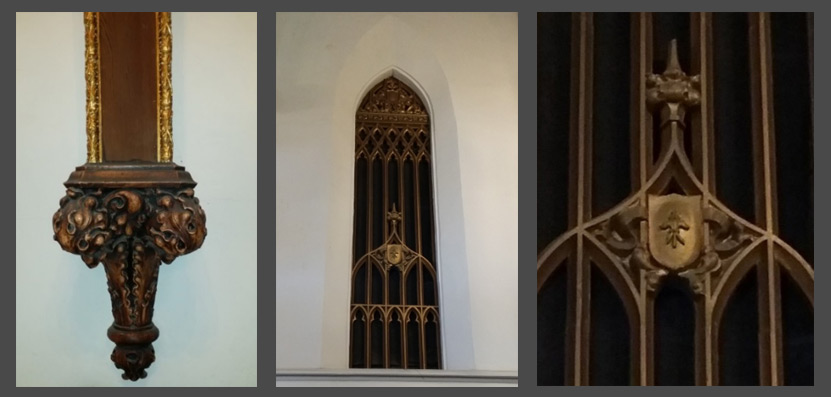
The following photographs show the sanctuary lamp and a chandelier. Originally, the chandeliers had crystal extensions, which can be seen in the following 1951 photograph of the December 28, 1951 wedding of Rayma Babbitt and Norman Sharber. The church was decorated for Christmas. Note the wall behind the altar without the mural.
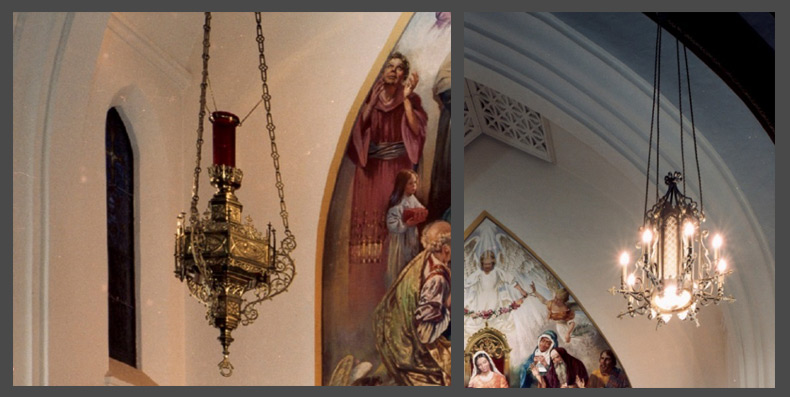

Originally estimated at $65,000, the total cost of the church was $105,000, a very significant sum in 1930. One half of the debt was paid immediately, with the residual erased from the books by 1947. This accomplishment was possible only with the dedicated efforts of a loyal congregation and the careful stewardship of Fr. Albouy.
 Postcard circa 1930
Postcard circa 1930The Dedication
On December 5, 1930, the front page banner headline on The Coconino Sun proclaimed the church’s approaching dedication day, calling the building “the most artistically perfect structure in Flagstaff. … In its noble and harmonious proportions, the richly dark furnishings, the color contrasts afforded in the colored windows, the interior of the building amply fulfills the promise made by its exterior.”
Also on the front page, Fr. Albouy extended a heartfelt invitation to the whole community as follows:
TO THE PEOPLE OF FLAGSTAFF:
I wish to express, through the columns of The Coconino Sun, my deep appreciation for the interest you have shown in the building of the new Catholic church. It has been my happy experience, throughout the construction period, to receive such encouraging and complimentary comments from you, that the worries and cares, inherent to enterprises of this kind, were made light for me.Now, thanks to your moral and financial support, I am naturally pleased to have brought this undertaking to a successful end, and to have contributed a little bit, through my personal efforts, to the beauty of our good city of Flagstaff.
I cordially invite you all, irrespective of Creeds, to the solemn dedication of the new Church of the Nativity next Sunday.
REV. EDWARD ALBOUY
The dedication mass was celebrated on Dec. 7, 1930.
In a masterful blend of scale and beauty, the steep roofline, buttresses, and richly detailed craftsmanship combine to impart a sense of bold and towering grandeur, tempered with a quiet, inviting intimacy. Skillfully balancing rugged volcanic stone with refined Gothic architecture, the colorful Munich-style stained glass windows provide the finishing touch on what has since become a treasured regional icon.
 Postcard circa 1930
Postcard circa 1930The Flagstaff Economy – 1930
The church was built during the great depression. It is remarkable that it was completed in a mere 15 months from breaking ground in Sept. 1929 - just one month before the stock market crash - until the dedication in Dec. 1930, with work suspended during the winter of 1929-30. Aside from Fr. Albouy’s skill in administering construction projects, a ready labor market is very likely the driving force behind the speed, as many local men were out of work.
In his “History of the Catholic Church in Flagstaff,” M. J. Riordan noted that “work was not let by contract, but by the day.” He also wrote in a letter dated August 26,1930, “It’s really wonderful to see how fast Father Albouy has been pushing the new church. I don’t know of any man who could have accomplished the work that has been done since the first stone was laid.” However, the following excerpts from two other letters reveal the depth and scope of the country’s economic downturn.
August 11, 1930
Mrs. William Riordan Quirke (M. J. Riordan’s daughter)
Ballinard Castle
Tethard, Co. Tipperary, Ireland
My dearest Clare:
“The fact is that there have been a great many places broken into lately. It is no doubt caused by the number of hoboes who are going through, and the great amount of unemployment throughout the country. I have said nothing about this but the fact is everything has slowed down in all parts of the country. Wages have been reduced everywhere and crowds of employees have been discharged, and there doesn’t seem to be any good reason think that there will be very much change for the better for a long time to come.
This condition seems to prevail throughout the world. I notice the reports from England are very gloomy, and certainly there is nothing over here to make one feel very sanguine over the outlook for a long time to come. The sheep and cattle men have been hit very hard, in fact most of the sheep men are going broke and many of them are broke already, and the same thing seems to be due for the cattle men unless there is a big change before long. I don’t think ever in our history have we done operating on so small a scale at this season of the year as we are doing this summer. The logging camp has been shut down completely and we are using up the logs already cut. We were operating the mill only three days a week but have now increased it to four, and then we are only operating half of the mill. It is really a very serious situation and particularly at this season of the year. Then too, in Ohio and Indiana and the western states the crops have been completely destroyed by the heat and the lack of rain. The effect of this will be felt in the fall, as the people on the farms will be beggared in a great number of instances. It is really one of the most alarming situations that I have seen in this country for many years.”
August 15, 1930
Mr. William Quirke (M. J. Riordan’s son-in-law)
Ballinard Castle
Tethard, Co. Tippeary, Ireland
My dear William:
“Things here have changed greatly in the United States since I was with you. There has been a constant decline. Unemployment is widespread; the production of all classes of goods has been very much beyond the possibility of getting rid of them at cost prices. I think that Arizona probably is in better condition than almost any part of the country, but even it has been hit harder than at any time within memory of residents here. For instance, the sheep business has gone plumb to pieces. Sheep that were selling a year ago at twelve and thirteen dollars a head are selling this year at less than five dollars and I think are going very much lower. Wool sold at less than any year for the last twenty and most of the sheep men are broke although few of them know it yet. Cattle has kept up better than anything else in the country, but recently they have been hit and by the time the large sales will be due in October and November I’m afraid that prices will be very much disarranged, and I would not be at all surprised if the cattle men suffered equally with the sheep men before the year is over. The same is true of lumber. Our own company has been operating only three days a week, though we started the full week lately in order to use up the logs in the woods before they blue. The lumber camp has been entirely disbanded. There is no one out there except Pat and his wife. The yard is full of lumber but there is no sale for it and any sale that we have is at a price less than the cost of production. The same is true of all the mills in the country. The mines too have shut down. The United Verde, for instance, at Jerome has discharged more than a thousand of its men. One doesn’t see much evidence of distress, notwithstanding the unemployment, but that is bound to come with the winter season.
The farmers throughout the country are in worse condition than has ever been known. I think most of them are mortgaged up to the value of their farms, and with the crops in the middle and center west practically destroyed, the farmers will be simply put on the road. It’s really a rather bad outlook and while the newspapers are all foretelling that the turn has just come, still for those who size it up sensibly there seems to be nothing in the future to indicate a true revival. You know as well as I do that the one thing that turns the scale upward when the world is on the decline is war. This is a hard thing to say but I believe it to be a true principle. It is one of the laws of nature. If trouble breaks out in Europe, as it is likely to, between France and Italy, involving many of the other nations, it would mean a change over here and throughout the rest of the world, but let us hope that such a remedy will not have to be depended upon.”
Rev. Edward D. Albouy
Born Sunday, August 3, 1884 in Rodez, France, Reverend Edward Dominic Albouy came to the United States, was ordained a priest Dec. 19, 1908 in Baltimore, Maryland, and subsequently traveled as a missionary to the Arizona Territory “under the direction of the Most Rev. Jean Baptist Lamy, first archbishop of Santa Fe, the man who brought a large wave of French missionary priests to the American southwest.” (Paul Switzer, The Sun, Sept. 18, 1976. … Arizona became a state February 14, 1912.)

Rev. Fr. Albouy built churches in several communities throughout Arizona including Solomanville (1912), Oatman (1916), and Winslow (1922). Fr. Albouy was assigned to Flagstaff in 1924, and built Guadalupe Church (1926), and Nativity of Blessed Virgin Mary Church (1930).
Pioneer and active parishioner M. J. Riordan, a key instigator of the building of the first Nativity Church in Flagstaff (1888), and later the building of Nativity of Blessed Virgin Mary Church (1930), wrote to Bishop Gercke of the Diocese of Tucson on September 13, 1930, praising Fr. Albouy:
“Father Albouy is getting along wonderfully with his church. He is really an astonishing man. Certainly no business man in this town would have undertaken, pushed, and gotten away with the work that he has done this summer, and the latest reports are that he is going to have things ready between the first and fifteenth of November, though I will be surprised if it can be done before Christmas. Personally, I never saw a priest who was able to do the things he does and to do them with so little effort and with never an indication of a complaint. He certainly is getting closer and closer to his model, the Curé d’Ars.”
(St. Jean-Baptiste-Marie Vianney, a French priest who became patron saint of all Priests, and often referred to as the “Curé d’Ars,” is pictured in one of the church’s stained glass windows. M. J. Riordan himself studied for the priesthood as a young man in Chicago. Health concerns forced him to move to Arizona in 1886, where he joined his brothers in the lumber business. Eventually, M. J.’s health deteriorated and in September 1930, he left Flagstaff by train to travel to the Mayo hospital in Rochester, MN, where he died Oct. 7, 1930, two months before the dedication of the church.)
By appointment of Pope Pius XII, Fr. Albouy was elevated to Domestic Prelate with title of Right Reverend Monsignor Sept. 9, 1947. He died July 2, 1952 in Cottonwood, AZ, from a heart attack.
Fr. Edward D. Albouy is buried in Flagstaff. His headstone and funeral card, as shown below, list his middle initial as “A.” However, the Diocese of Tucson form filled out in Fr. Albouy’s own handwriting clearly reads “Edward Dominic Albouy.”


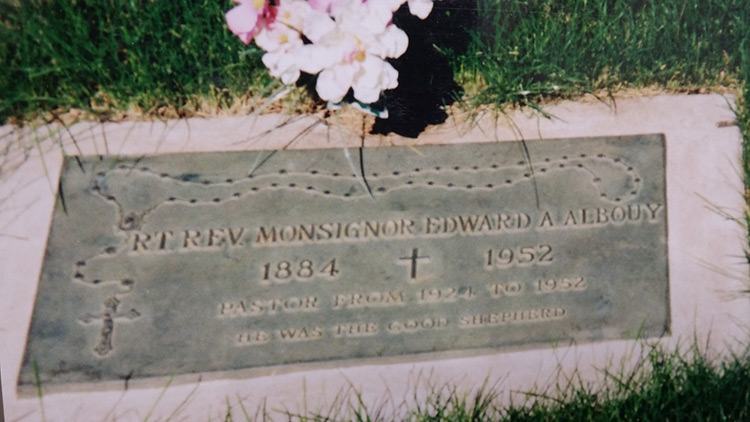
Donors Of Statues & Other Gifts – 1930
Donor – Item - In Memory of:
- Mrs. Colin Campbell, Communion rail & tabernacle, In memory of Hugh Daze Campbell
- Mrs. William Babbitt, Stations of the Cross, In memory of William Babbitt
- T. E. McCullough, Sanctuary lamp
- Rt. Rev. Daniel J. Gercke, Bishop of Tucson, Statues of St. Peter and St. Paul
- J. C. Dolan, Sacred Heart Statue, In memory of Dolan Family
- Mrs. Edna B. Babbitt, Blessed Virgin Mary, In memory of Emma Walker Buggeln
- Mrs. Robert R. Chambers, St. Therese of Jesus, In memory of Anna Riordan
- Ladies of the Altar Society, Altar adoring angels
- Young Ladies’ Sodality, Altar water fonts
- E. T. McGonigle Family, Cornerstone, In memory of Charles McGonigle
- E. T. McGonigle Family, Chandelier, In memory of Veronica McGonigle
- Jeff Williams, Chandelier
- Dr. H. W. Swigert, Altar cards
- Mrs. Anna Rickel, Sacred Heart Statue, In memory of T. A. Riordan
- Mr. & Mrs. Don J. McMillan, Angel statue, In memory of Don R. McMillan
- Mr. & Mrs. Dennie O’Brien, Angel statue, In memory of Moran O’Brien
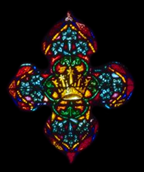
~ Ave Maria ~
